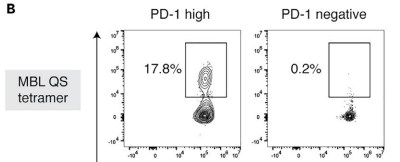Published by Beata Boczkowska, Ph.D. on Jan 30, 2024 9:35:24 AM

MBLI QuickSwitch™ Custom Tetramer kits are designed to create custom tetramers for both human and mouse Class I MHC, as well as human Class II MHC Tetramers. With just one kit, you can easily perform peptide-MHC exchange and accurately quantify your exchange without the need for complex or difficult techniques like UV cleavage!
Here are the highlights of some the influential publications that have utilized MBLI QuickSwitch™ Custom Tetramer Kits in 2023.
2023 QuickSwitch™ Publications Related to Pathogens
A study published in Nat Commun by Tai, W., et al. (2023) (5) utilized MBLI QuickSwitch™ Custom Tetramer Kits to generate HLA A*02:01 and HLA-A*11:01 tetramers with SARS-CoV-2 epitopes to assess substitutions in the non-structural proteins. The QuickSwitch™ Custom Tetramer Kits (TB-7300-K1 for HLA-A*02:01 and TB-7304-K1 for HLA-A*11:01) generated wild-type, mutant and positive control tetramers and stained CD8+ T cells. The data revealed three specific HLA-I epitope-enriched peptides within the nonstructural proteins of SARS-CoV-2 that exhibited high immunogenicity, resulting in the activation of human CTL responses (5).
Zhou, Yuqi, et al. (2023) study in PLOS Pathogens (1) demonstrated the ability to effectively manage HIV replication is closely linked to the capacity of engineered T cells to trigger cell death in HIV-infected T cells. This study suggests that the speed at which T cell recognition and initiation of T cell-mediated killing occur is a crucial factor in determining whether engineered T cells can effectively control viral infections. MBLI QuickSwitch™ HLA-A*02:01 Custom Tetramer Kit-PE was used to generate tetramers for this study.
2023 QuickSwitch™ Publications Related to Cancer
Another study published in Nat Commun by Saotome, K., Dudgeon, D., Colotti, K. et al. (2023) used cryoEM to examine TCR-pMHC recognition, with emphasize on affinity α/β TCRs derived from humanized mice that target a peptide from the cancer-testis antigen MAGE (9). To determine which of the two substitutions (V2L and T9S) is responsible for the preferential binding of the TCRs to MAGEA4 over MAGEA8, each custom peptide was loaded onto the QuickSwitch™ HLA-A*02:01 Tetramer (PE, TB-7300-K1). The peptide exchange resulted in tetramers that were used in flow analysis to evaluate the binding of antigens to the TCRs. The flow cytometry data showed the pMHC tetramers binding to primary human T cells expressing PN45428 or PN45545 TCRs, and indicated that both PN45428 and PN45545 preferentially bind to MAGEA4 (9).
Shin et al.,2023 (8), evaluated the therapeutic efficacy of FAP Nano vaccines alone and in combination with an anticancer drug in ECM-rich desmo-plastic tumor models. The Immunodominant Epitope Peptides of FAP were predicted using three epitope-prediction program. The QuickSwitch™ Quant H-2 Kb Tetramer Kit-PE was used to accurately measure the presence of FAPPEP1-specific CD8+ T cells within the lymph node. The tetramer assays showed a significant increase in the percentage of H-2Kb FAPPEP1 tetramer+ CD8+ T cells exclusively in the FAPPEP1-SLNP-immunized group, as compared to the untreated control group (8).
Cell Press STAR publication: comparison of the UV cleavable technology and QuickSwitch™ Custom Tetramer Kit.
The paper details a protocol which examines T cells from transplanted organs with tissue-specific peptides. QuickSwitch™ Custom Tetramer Kits were used to generate multiple tetramers in order to screen an array of >100 pMHC epitopes (12). Additionally, Son, Eric T., et al., 2023 performed a direct comparison of the UV cleavable technology and, QuickSwitch™ Custom Tetramer Kit. When compared to the UV peptide exchange detection method, QuickSwitch™ detected a higher percentage of T cells with better single to noise ratio, indicating less likelihood of false positive results (12).

The aforementioned publications offer a glimpse into the recent studies that have utilized MBLI's QuickSwitch™ Custom Tetramer kits. For additional citations, please see the references section here or visit our website. You can also explore our current QuickSwitch™ Custom Tetramer QuickSwitch kit offerings or reach out to us for personalized support.
References
- Zhou, Yuqi, et al. “Chimeric antigen receptors enable superior control of HIV replication by rapidly killing infected cells.” PLoS pathogens 19.12 (2023): e1011853.
- Zhang, Yang, et al. “Complete remission of tumors in mice with neoantigen-painted exosomes and anti-PD-1 therapy.” Molecular Therapy (2023).
- Wu, Ming, et al. “Spleen‐targeted neoantigen DNA vaccine for personalized immunotherapy of hepatocellular carcinoma.” EMBO Molecular Medicine (2023): e16836.
- Qin, Lijuan, et al. “GPC3 and PEG10 peptides associated with placental gp96 elicit specific T cell immunity against hepatocellular carcinoma.” Cancer Immunology, Immunotherapy (2023): 1-18.
- Tai, W., Feng, S., Chai, B. et al. An mRNA-based T-cell-inducing antigen strengthens COVID-19 vaccine against SARS-CoV-2 variants. Nat Commun 14, 2962 (2023).
- Wang, Wenfeng, et al. “Lymphatic endothelial transcription factor Tbx1 promotes an immunosuppressive microenvironment to facilitate post-myocardial infarction repair.” Immunity (2023).
- Xiao, Jingyu, et al. “Engineering In Vitro Organ‐Structured Tumor Model for Evaluating Neoantigen‐Specific T Cell Responses in Hepatocellular Carcinoma.” Advanced Materials Interfaces (2023): 2300155
- Shin, Hocheol, Yujin Kim, and Sangyong Jon. “Nanovaccine displaying immunodominant T cell epitopes of fibroblast activation protein is effective against desmoplastic tumors.” ACS nano (2023). 10.1021/acsnano.3c00764
- Saotome, K., Dudgeon, D., Colotti, K. et al. Structural analysis of cancer-relevant TCR-CD3 and peptide-MHC complexes by cryoEM. Nat Commun 14, 2401 (2023). doi:10.1038/s41467-023-37532-7
- Bruno, Peter M., et al. “High-Throughput, Targeted MHC Class I Immunopeptidomics Using a Functional Genetics Screening Platform.” Nature Biotechnology, 2023, doi:10.1038/s41587-022-01566-x.noue, Shinya, et al. "Induction of potent antitumor immunity by intradermal DNA injection using a novel needle‐free pyro‐drive jet injector." Cancer Science 114.1 (2023): 34.
- Li, Yuanke, et al. "Tumor Cell Nanovaccines based on Genetically Engineered Antibody‐anchored Membrane." Advanced Materials (2023): 2208923.
- Son, Eric T., et al. “Screening Self-Peptides for Recognition by Mouse Alloreactive cd8+ T Cells Using Direct Ex Vivo Multimer Staining.” STAR Protocols, vol. 4, no. 1, 2023, p. 101943., doi:10.1016/j.xpro.2022.101943.

